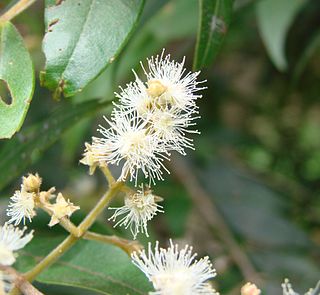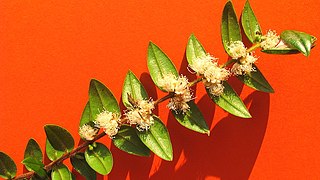
Psidium is a genus of trees and shrubs in the family Myrtaceae. It is native to warmer parts of the Western Hemisphere.

Myrciaria floribunda, commonly known as cambuizeiro, guavaberry or rumberry, is a species of plant in the family Myrtaceae. It can be found across South and Central America and the West Indies in dry or moist coastal woodlands, up to 300 metres above sea level. The guavaberry, which should not be confused with the guava, is a close relative of camu camu.

Ugni is a genus of plants in the myrtle family Myrtaceae, described as a genus in 1848. It is native to western Latin America from the Valdivian temperate rain forests of southern Chile and adjacent regions of southern Argentina, north to southern Mexico.

Jabuticaba is the edible fruit of the jabuticabeira or Brazilian grapetree. The purplish-black, white-pulped fruit grows directly on the trunk of the tree. It is eaten raw or used to make jellies, jams, juice or wine. The tree, of the family Myrtaceae, is native to the states of Rio de Janeiro, Minas Gerais, Goiás and São Paulo in Brazil. Related species in the genus Myrciaria, often referred to by the same common names, are native to Brazil, Argentina, Paraguay, Peru and Bolivia.

Myrciaria is a genus of large shrubs and small trees described as a genus in 1856. It is native to Central and South America, Mexico, and the West Indies, with many of the species endemic to Brazil. Common names include hivapuru, sabará, and ybapuru.

Myrcia is a genus of plants in the family Myrtaceae, containing about 765 species as of 2022. They are distributed in Central and South America, Mexico, and the Caribbean, with centers of diversity in the Brazilian Cerrado and Atlantic Forests ecoregions. Myrcia was first described as a genus in 1827.

Plinia is a genus of flowering plants in the myrtle family, Myrtaceae described by Linnaeus in 1753. It is native to Central and South America as well as the West Indies.
Myrciaria cuspidata, commonly known as camboim, or cambuím is a species of plant in the family Myrtaceae. It is found in coastal forests and semideciduous forests in Brazil, Paraguay and Argentina. It grows slowly to a semideciduous shrub or small tree, between 3 and 6 metres tall, with orange or black berries around 10mm in diameter.
Myrciaria plinioides, commonly known as camboim, cambuim, or cambuí, is a species of plant in the family Myrtaceae. It is a shrub that is endemic to Rio Grande do Sul in the south of Brazil.
Myrciaria silveirana is a species of plant in the family Myrtaceae. It is endemic to Brazil.
Calycolpus warscewiczianus is a plant species native to Nicaragua, Costa Rica, Panamá and Venezuela.

Myrteae is the largest tribe in the plant family Myrtaceae. It includes most of the species of the family that have fleshy fruits.
Myrciaria delicatula, commonly known as cambuí uvaia doce, cambuí graudo, cambuim, or cambu branco, is a species of plant in the family Myrtaceae.

Myrciaria strigipes, commonly known as cambucá da praia or cabeludinha da praia, is a species of plant in the family Myrtaceae. It is an evergreen shrub or small tree, endemic to Bahia and Espírito Santo in the east of Brazil. The plant grows up to between 4 and 9 metres tall, and produces edible yellowish fruits between 22 and 28mm in diameter. Consumed raw, the fruit has been described as tasting somewhere between Myrciaria glazioviana and Plinia cauliflora.
Plinia rivularis, commonly known as yva poroity, jaboticabarana, jabúriti, guapuriti, cambucá peixoto, jabuticaba de cacho, or piuna is a species of plant in the family Myrtaceae.
Myrciaria alagoana is a species of plant in the family Myrtaceae and is endemic to the state of Alagoas in the east of Brazil. Myrciaria alagoana was first described in 2012 and is related to Myrciaria glomerata.
Myrciaria tenella, commonly known as cambuí or camboim, which are also used to describe Myrciaria cuspidata and Myrciaria delicatula; or more specifically jabuticaba-macia, and cambuí-açu, is a species of plant in the family Myrtaceae.
Myrciaria cambuca, named after its common name cambucá, is a species of plant in the family Myrtaceae. First described in 2019, it is a small shrub with reddish fruit, and was previously misidentified as Myrciaria ferruginea.
Myrciaria evanida is a species of plant in the family Myrtaceae. It is endemic to Espírito Santo and Minas Gerais in Brazil. First described in 2013, it resembles Myrciaria floribunda.
Myrciaria puberulenta is a species of plant in the family Myrtaceae. It is endemic to evergreen moist forests in southern Venezuela and was first described in 2002. The Piaroa people cultivate it for its fruit and call it "kuyaeri".








